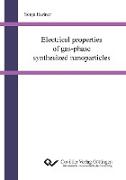Electrical properties of gas-phase synthesized nanoparticles
BücherAngebote / Angebote:
AbstractZinc oxide (ZnO) doped with aluminum receives increasing attention for being an alternative material for the established but much more expensive indium tin oxide (ITO) due to the fact, that it has comparable electrical and optical properties. The electrical properties of mechanically compacted pellets prepared from nanosized ZnO powders are investigated using impedance spectroscopy. The impedance of the samples is measured in hydrogen and in synthetic air between room temperature and 400?C. In both atmospheres, the measurements show two different electrical transport processes depending on the temperature and the doping level. In synthetic air, the conductivity increases for doping concentrations up to 7.74% of aluminum and collapses for higher doping levels. In hydrogen atmosphere, the conductivity decreases with rising doping level of Al. This behavior can be explained by generation of free charge carriers due to the incorporation of hydrogen and doping with aluminum, respectively. At higher temperatures and at high doping concentrations, scattering processes at grain boundaries as well as lattice defects increasingly affect the charge carrier transport processes leading to a decreasing overall conductivity. The electrical conductivity shows reversible behavior when the atmosphere is changed from hydrogen to ambient conditions and back. To replace ITO in applications, transparent conductive layers with good electrical and optical properties are required. ZnO dispersions are prepared and printed on pre-structured substrates by ink-jet printing to investigate the electrical and sensing properties of printed films. The properties are measured without any annealing steps from room temperature up to 200?C in ambient conditions and in hydrogen atmosphere using impedance spectroscopy. Compared to the measurements in air, the resistance in hydrogen decreases by a factor of five even at room temperature. The ink-jet printed ZnO films with nanosized particles can be used as sensor without any annealing or post-processing for sensing.Silicon (Si) nanoparticles are envisioned for a broad range of applications, ranging from electroluminescent devices over biomarkers and lithium ion batteries to solar cells. One of the major challenges with respect to these applications is to effectively stabilize the silicon particles against oxidation. Electrical properties of as-prepared as well as functionalized silicon nanoparticles are investigated. The native oxide shell of the as-prepared silicon nanoparticles is removed and the electrical properties are measured and a re-oxidation of the silicon nanoparticles can be observed after a few hours. A fast and efficient process to functionalize silicon nanoparticles with n-alkenes is introduced. The freshly etched particles are subsequently grafted with even-numbered n-alkenes from C6 to C18 in order to prevent the particles from re-oxidation. FTIR spectra are used to confirm the successful attachment of the organic molecules and provide insight into the binding mechanism. Electrical properties are investigated by impedance spectroscopy showing the effect of surface functionalization on the conductivity of compacted nanoparticle ensembles. It is observed that particles covered with alkenes from C6 to C12 exhibit higher conductivity than the as-prepared materials, while surface functionalization with C14 and higher leads to almost insulating nanoparticle arrays. Despite freshly etched silicon nanoparticles, dodecene-terminated particles showed the best conductivity as well as a very good long-term stability against oxidation. FTIR spectroscopy indicated that particles stabilized with C6 to C10 are less stable due to a creeping re-oxidation. The most promising results is the functionalization of silicon nanoparticles with alkenes with twelve carbon atoms (C12). A variable range hopping transport mechanism or a charge carrier limited transport mechanism exist for all silicon nanoparticles. Especially for the functionalized particles, a dependence of the hopping distances can be observed. This does not mean that the charge carriers use the shortest way but the energetically most advantageous.
Folgt in ca. 5 Arbeitstagen

